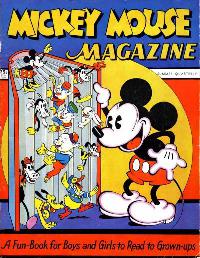Years in Print:
1935 - 1940

Detail
Publisher:
 Western
Country:
Western
Country:
 United States
Language:
English
Issues:
v1 #1 [1] - v5 #12 [60] (60 Issues)
United States
Language:
English
Issues:
v1 #1 [1] - v5 #12 [60] (60 Issues)
 Continued From:
none
Continued From:
none
 Continued In:
none
Continued In:
none
 Tracking Notes:
Tracking Notes:
 Notes:
This magazine, the third and final incarnation of Mickey Mouse Magazine, was a full-scale periodical. The new magazine had a full-color cover, and an interior color centerfold.
Notes:
This magazine, the third and final incarnation of Mickey Mouse Magazine, was a full-scale periodical. The new magazine had a full-color cover, and an interior color centerfold.
Hal Horne, who had edited the second series, was the initial editor and publisher of this third series, and he resigned from United Artists to devote himself full-time to his publishing company, Hal Horne Inc.
By mid 1936, Horne was in financial difficulties, and asked Kay Kamen to buy him out. Kamen reluctantly agreed, and Horne returned to the motion picture industry. Kamen sold a large number of excess copies of the early issues to foreign countries, which made the magazine profitable.
Kamen's run of the magazine began with issue #10 (July 1936), under the company name "Kay Kamen Ltd". The artists who contributed to the magazine were from Kamen's staff, including John Stanley, and Otto Messmer. The magazine printed some non-Disney material, including Messmer's strip Bobby and Chip, which ran from 1936 to 1938, and Benny Bug, which appeared in the magazine in 1936.
Kamen introduced reprints of the Disney comic strips to the magazine in response to the emerging comic book market; reformatted Sunday pages from Ted Osborne and Floyd Gottfredson's Mickey Mouse were introduced in issue #16, and Osborne and Al Taliaferro's Silly Symphony Sunday pages in issue #17 (Feb 1937).
In 1937, Kamen went into partnership with Edward Wadewitz, founder of Western Printing and Lithographing Company. They formed the new imprint "K.K. Publications". Issue #21 (June 1937) was the first published under the new imprint; this was also the first issue to have half of the pages printed in color.
Issue #48 (Sept 1939) was the first issue to be published in full color, but the number of comics pages still remained the same, usually five pages. In issue #57 (June 1940), the magazine shrank to the traditional comic book size.
The final issue, #60 (Sept 1940), is seen as a "transition issue", in which the magazine became a full-fledged comic book, just in time for a reboot. The size doubled to 64 pages, the usual size of a comic book at the time, including 34 pages of comic strip reprints. The magazine was then cancelled and replaced with Walt Disney's Comics and Stories.
What should have been v3#1 was actually numbered v2#13, and there was no v3#1. There were also two v4#7's and no v4#6.
Does this data need corrections? Become an editor.

Sample Issue Image



 Western
Country:
Western
Country:
 United States
Language:
English
Issues:
v1 #1 [1] - v5 #12 [60] (60 Issues)
United States
Language:
English
Issues:
v1 #1 [1] - v5 #12 [60] (60 Issues)
